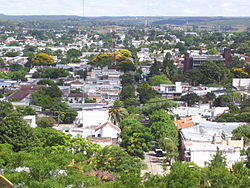Rivera Department
The Rivera department (Spanish: Departamento de Rivera) is a department of Uruguay. The capital is the city of Rivera.
Rivera | |
|---|---|
 View of Rivera from Cerro Marconi. | |
 Location of Rivera, in red, in Uruguay | |
| Coordinates: 30°53′40″S 55°32′17″W / 30.89444°S 55.53806°W | |
| Country | |
| Creation | 1884 |
| Capital | Rivera |
| Government | |
| • Intendant | Marne Osorio Lima[1] |
| Area | |
| • Total | 9,370 km2 (3,620 sq mi) |
| Population (2011)[2] | |
| • Total | 103,493 |
| • Density | 11/km2 (29/sq mi) |
| Time zone | UTC-03 (UYT) |
| ISO 3166 code | UY-RV |
| Website | Official website |
Its ISO 3166-2 code is UY-RV.
Name
changeThe department and its capital city are named after Fructuoso Rivera (1784–1854), first president of Uruguay.
Geography
changeThe Rivera department is in the northern part of the country. It has an area of 9,370 km2 (3,618 sq mi), the 11th largest in the country. It is the eighth department with more people living in it, with a population of 103,493 inhabitants (2011 census) for a population density of 11.0.
There are three chains of low and rounded hills in the department. These chains of are known as cuchillas in the country. At the northwest end of the department is the Cuchilla de Haedo, one of the most important cuchilla of the country, coming from the south; it meets the Cuchilla Negra that comes from the north. Between these two hill ranges is the Cerro de los Peludos hill. Along the borders with Brazil, to the north, runs the Cuchilla de Santa Ana.
In the middle of the department is the hill Cerro de la Cruz, while on its eastern end are the hills Cerro del Hospital and Cerro Bonito.
Limits
change- To the north: Brazil
- To the east: Brazil, and Cerro Largo department separated by the Río Negro river.
- To the south: Tacuarembó department separated by the Río Tacuarembó river.
- To the west: Tacuarembó and Salto department.
Rivers
changeAlong the eastern borders of the department with Cerro Largo Department flows the Río Negro river, with its tributaries flowing through the easternmost part of the department.
The western part of its southern border with the Tacuarembó Department is formed by the Tacuarembó river (a tributary of the Río Negro river, with its tributaries flowing through most of the department.
Climate
changeThe Köppen climate classification type for the climate at Rivera is a "Humid subtropical climate" and of the subtype Cfa.[3]
The average amount of precipitation for the year in Rivera is 1,638.3 mm (64.5 in). The month with the most precipitation on average is October with 162.6 mm (6.4 in) of precipitation. The month with the least precipitation on average is June with an average of 101.6 mm (4.0 in).
The average temperature for the year in Rivera is 16.7 °C (62.1 °F). The warmest month, on average, is January with an average temperature of 23.9 °C (75.0 °F). The coolest month on average is June, with an average temperature of 10.6 °C (51.1 °F).
Demographics
changeThe inhabitants of the Rivera department (and of the city of Rivera) are known, in Spanish, as Riverenses.
Evolution of the population in Rivera

- Rural population
According to the 2011 census, the Rivera department has a rural population of 7,602.[2]
- Main towns
| City / Town | Population (2011) |
|---|---|
| Rivera | 64,485 |
| Tranqueras | 7,235 |
| Mandubí | 6,019 |
| Minas de Corrales | 3,788 |
| Vichadero | 3,698 |
| La Pedrera | 3,363 |
| Santa Teresa | 2,657 |
| Lagunón | 2,376 |
Gallery
change-
Rincón de Tres Cerros.
-
Valle del Lunarejo.
Related pages
changeReferences
change- ↑ "La institución" (in Spanish). Intendencia Departamental de Rivera. Retrieved 11 August 2017.
- ↑ 2.0 2.1 "Censos 2011". Instituto Nacional de Estadística. 10 August 2012. Archived from the original on 5 March 2011. Retrieved 11 August 2017.
- ↑ "Rivera, Uruguay - Köppen Climate Classification". Weatherbase. Retrieved 11 August 2017.
Other websites
change- Intendencia Departamental de Rivera website (in Spanish)
- Statoids - Departments of Uruguay
- Enciclopedia Geográfica del Uruguay: Rivera (in Spanish)

